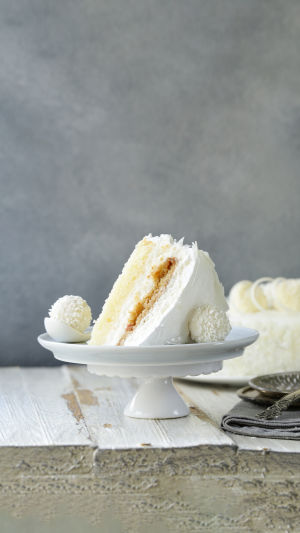There's something undeniably delightful about a well-baked coconut cake.
With its luscious layers, subtle sweetness, and tropical flair, it has earned a special place in the hearts of dessert aficionados from all around the world.
One such iteration, the creamy coconut cake, stands out for its rich, decadent texture and exquisite blend of flavors. In this essay, we will explore the history, ingredients, preparation, and sheer delight that creamy coconut cake brings.
The history of coconut cake can be traced back to the South Pacific and Southeast Asia, where coconut trees flourish. As coconuts made their way to different parts of the world, so did the concept of coconut-infused desserts.
The creamy coconut cake we know today has evolved over centuries, with each culture adding its unique twist. Whether it's the Filipino Bibingka or the American coconut layer cake, coconut has been celebrated in various forms throughout history.
The star ingredient, unsurprisingly, is coconut. Both coconut milk and shredded coconut are pivotal players in creating the distinctive flavor and texture of creamy coconut cake. Coconut milk, extracted from the grated flesh of the fruit, adds a rich and velvety consistency to the cake.
Shredded coconut, usually toasted to enhance its flavor, offers a delightful contrast in texture and a burst of tropical sweetness. Other essential ingredients include sugar, flour, eggs, butter, and leavening agents, but the real magic happens when these ingredients combine with the coconut.
The preparation of a creamy coconut cake is an art form in itself. To begin with, the baker prepares a light and fluffy sponge cake or a moist and buttery pound cake as the base. The choice of cake base can vary depending on regional preferences and personal taste.
Once the cake layers are baked and cooled, they are generously soaked with a mixture of sweetened condensed milk and coconut cream. This infusion of sweetness and tropical flavor ensures each bite is a moist and delectable experience.
The filling between the layers is often a luscious coconut custard or a velvety coconut cream. The custard is created by combining egg yolks, sugar, coconut milk, and a touch of cornstarch, creating a silky-smooth filling that complements the cake's texture beautifully.
On the other hand, the cream is a whipped concoction of coconut cream, powdered sugar, and a hint of vanilla, delivering a cloud-like, coconut-infused layer between the cake tiers.
The crowning glory of the creamy coconut cake is, of course, the frosting. Cream cheese frosting, often infused with coconut flavor, is a popular choice. It's rich, tangy, and slightly sweet, providing the perfect balance to the cake's sweetness.
The frosting is generously applied to the cake, and the sides are often coated with a layer of toasted shredded coconut, adding an extra crunch and enhancing the cake's tropical aesthetic.
The result is a dessert feast for the eyes and the palate. The creamy coconut cake is the epitome of indulgence, offering a delightful interplay of textures and flavors. Each forkful delivers a burst of coconut essence, a creamy custard or cream layer, and the satisfying bite of toasted shredded coconut.
Whether enjoyed on a special occasion or as a sweet treat to brighten an ordinary day, creamy coconut cake is a testament to the universal appeal of coconut flavor and versatility. It has the power to transport you to a tropical paradise with each bite, making it a beloved dessert around the world.
The creamy coconut cake is a testament to the enduring popularity of coconut as an ingredient in the world of desserts. Its rich history, delightful ingredients, meticulous preparation, and, most importantly, its mouthwatering flavor make it a standout choice for anyone with a sweet tooth.
From the South Pacific to your kitchen table, creamy coconut cake is a slice of tropical delight that continues to captivate and enchant.





